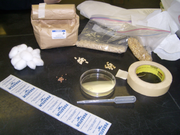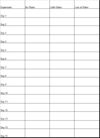Can your seeds grow here?
| Instant wiki maker | Making handouts | Editing tips |
Biology In Elementary Schools is a Saint Michael's College student project from a course that ran between 2007 and 2010 and fully described in this book chapter. The student-created resources have been preserved here for posterity. Link under 'toolbox' for printer-friendly versions of the exercises. Click on handouts to print full resolution versions. Please see Wikieducator's disclaimer, our safety statement, and the Creative Commons licensing in English and in legalese.
Student worthiness
Tested and Worked. However, these dishes will mold and should not be opened afterwards, (Safey Note).
Primary biological content area covered
- Life Science: "Understand how plants grow under different conditions"
- Scientific Method
- Experimental design
Materials
Materials Required For Each Student Group: (Fig. 1)
- Cotton balls
- Water
- 18 plastic petri dishes
- Any kind of seeds
- We used Corn seeds
- We used Baby bop seeds
- We used Radish seeds
- Eye dropper
- Parafilm (one could use tape if you do not have parafilm)
- Cardboard
- Tape
Materials That Each Individual Student Would Need:
- Worksheet: each student will recieve their own tracking chart
Handouts
Students will be given an individual tracking chart to document the progress of their groups seeds growth on a day to day basis. As the students observe the three different types of seeds growing in the petri dishes each day, they will be instructed to record their observations on their individual tracking chart. (Fig. 2)
Description of activity
Using corn seeds, baby bop seeds, and radish seeds, students will conduct an experiment of how these seeds grow with different amounts of water.
Lesson plan
- Each group will recieve three plastic petri dishes (Fig. 3), cotton balls, seeds, and an eye dropper.
- Students will receive instructions on how the experiment is going to run. Students will be instructed to fill the bottom of each petri dish with cotton balls, to add the three types of seeds to each petri dish, and to add a certain amount of water to two of the dishes. They will then be required to keep a tracking chart of the growth of their seeds to discover under which conditions the seeds grow best (in regards to amounts of water).
- Once the instructions have been laid out, the students will be asked to come up with their own hypothesis as to what will happen during the experiment, and will explain their reasoning behind their hypothesis. Their hypothesis will be in regards to which petri dish they think will germinate the most: the dish with no water, the dish that is damp, or the dish that is soaked with water.
- Once their hypothesis is complete the students will begin to line the bottom of their three petri dishes with cotton balls. The bottom of the petri dishes should be completely covered with 9 cotton balls (Fig. 4).
- After the cotton balls have been added to the petri dishes, it is time to add the seeds. The students will gently place 3 of each type of the three seeds on top of the cotton balls in each dish (Fig. 5).
- On the lids of the three petri dishes the students will label the following: Dish 1 no water, Dish 2 damp, and Dish 3 soaked.
- After the seeds have been added the students will place different amounts of water in two of the dishes. Dish 1 will contain no water. Dish 2 will be slightly damp (gently drop water onto the cotton balls using an eye dropper for a total of 60 drops) (Fig. 6). Dish 3 will be completely soaked with water, using the eye dropper students will add water to the cotton balls until they are completely soaked (Fig. 7).
- Once the water has been added the students will close up the lids of the petri dishes and will seal each petri dish with parafilm (Fig. 8). Place the dishes vertically by the window.
- The students will then be instructed, that every day for the next two weeks they will be required to observe and record the growth of their seeds' on their individual tracking chart. The students will use a ruler to measure the growth of the seeds each day (in centimeters). In the classroom the teacher can tape the petri dishes to a cardboard box. (Make sure the box is standing vertically) (Fig. 9).
- At the end of the two weeks, the students will look at their data and will be able to tell if their hypothesis was supported or rejected.
- Note: When the experiment is done, the book A Seed Is Sleepy, will be read to the students and a discussion will follow.
- Students performing ''Can Your Seeds Grow Here?'' experiment
Potential pitfalls
- The volume of water in each petri dish may vary among the different groups.
- Some seeds may be older than others, so therefore some seeds may not grow.
Math connections
- Students could be asked how many seeds are in each petri dish. At the first grade level, the students would need help arriving at the answer. Since there are three different types of seeds and three of each type in each petri dish, we could set up the problem for the students and then have the students arrive at the answer. There could be three groups of seeds, each group being one kind of seed. In each group there would be three of that type of seed: three corn seeds, three baby bop seeds, and three radish seeds. Students could add the three groups of seeds together to find out how many seeds are in one petri dish. At the first grade level, students could count the seeds using one to one correspondance, and would arrive with the answer of nine seeds in each petri dish.
- When the students add the water from the eye dropper to the "damp" petri dish, the students will have to count out sixty drops into the petri dish.
- Math will also be incorporated into this lesson due to the fact that the students will measure their seeds growth, by means of using a ruler.
Literature connections
- Jordan, H. 1992. How a Seed Grows. New York: HarperCollins.
- Aston, D. and S, Long. 2007. A Seed Is Sleepy. New York: Chronicle Books LLC.
Connections to educational standards
- S1-2:34 Students demonstrate their understanding of Energy Flow in an Ecosystem by...
- Experimenting with plant growth under different conditions,including light and no light. (Addressing this standard, but with a different variable, amounts of water).
- S1-2:2 Students demonstrate their understanding of PREDICTING AND HYPOTHESIZING by...
- Predicting a logical outcome to a situation, using prior knowledge, experience and/or evidence. AND..explaining reasons for that prediction.
- S1-2:7 Students demonstrate their ability to EXPLAIN DATA by...
- Developing a reasonable explanation based upon observations (e.g. I found out...).
- Concept # 4- Life Science: "Understand how plants grow under different conditions," (Taken from Mater Christi School Standards for Science)
Next steps
- After this experiment is completed, other variables could be discussed and explored. For example: is light necessary for growth, is soil needed, and does the petri dish need to be sealed?
Reflections
- Seeing how this was our first time teaching a lesson to students, I thought that we did a great job. After planning the lesson it was fun to see everything come together. I thought that the first graders from Mater Christi came with a lot of good background knowledge. Each student came to us with the knowledge of what a hypothesis is. With the students only in first grade, I thought that their background knowledge of what a hypothesis is, was truly amazing. This background knowledge allowed them to think of their own hypothesis for our activity. They not only thought of a hypothesis, but they also explained their reasoning behind their hypothesis. One thing which I learned from this experience, was that in the future when giving a handout to students to take home, explain and show it to the students, but do not hand it out until the students are leaving. For a few of the students, the handout seemed to be a distraction for them, while the rest of the lesson was taking place.
Citations and links
- Science standards taken from the Vermont Department of Education website. http://www.education.vermont.gov/
- A useful website on germination: http://en.wikipedia.org/wiki/Germination
- Other useful websites about seeds and germination:
- Jordan, H. 1992. How a Seed Grows. New York: HarperCollins.
- Aston, D. and S, Long. 2007. A Seed Is Sleepy. New York: Chronicle Books LLC.









